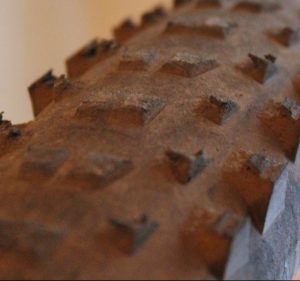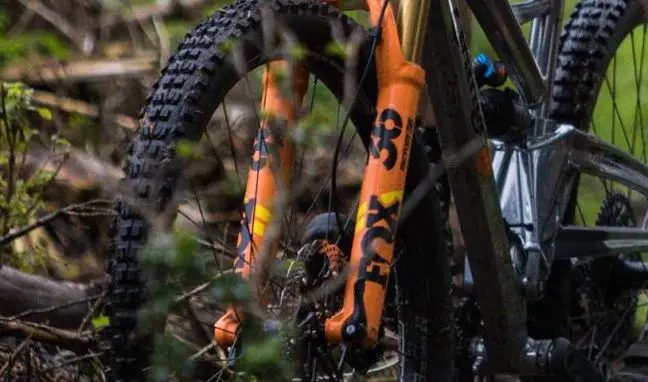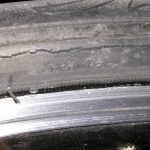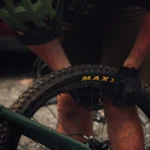Mountain bike tires wear down slowly over time, and it can be difficult to know exactly when you should replace them. Many times, they are replaced when they still have plenty of life left in them.
You should look to replace your mountain bike tires when the knobs in the tread are more than halfway worn down, you can see the threads beneath the rubber in places, the tire has bulges in some spots, the tire won’t hold pressure, or there is excessive cracking in the tire from dryrot.
What Are The Signs You Need To Replace Your MTB Tires?

Aside from the tires not having the same traction and handling as usual, there are some signs of what to look for to know you will have to get new tires in the near future.
Generally speaking, these are the signs that your bike tires are worn and need to be replaced:
- The knobs on the tire are rounded and not as tall as they were when new. This is normally noticed on treads in the center of the tire. Note in the picture they are more rounded so they dig into the dirt less and don’t have the traction of new tires.
- You can see the threads beneath the rubber in places
- The tire has bulges in some spots
- The tire won’t hold pressure. This is common on road tires.
- Excessive cracking of the tread separating from the rest of the tire
Any one of these is caused to get new tires. It’s just not worth the risk if you’re not 100% sure they’re safe after examining them. Replace tires when it’s time to avoid an accident.
How To Make MTB Tires Last Longer
Bike tires never last as long as any of us would hope, but there are some things you can do to get a little more life out of them.
- Ensure tires are inflated to the correct pressure.
- Keep your bike stored out of the sun. UV rays make the tires more brittle and break down the rubber faster.
- Don’t do skids on hard surfaces
- Track how many miles you ride. This generally gives you an idea of how long the tires will last and gives you an idea for when they’ll wear out.
- Try to ride on smoother terrain like cross country trails if you have the option. This is a tough one because rocky terrain is where the adrenalin is.
Whether you have mountain bike tires or road bike tires, the same important maintenance guide applies to help get the most out of your bicycle tires and will give you the most time before you need to replace bike tires.
Make sure you check the tires before every ride.
Make sure you are aware of times when the tires slip when they should grip.
Make sure to take note of cracks in the sidewalls and the tires needing to get topped off with air regularly.
Most of these tires fall in the $50-60 range and it’s not worth sliding into a tree or slipping and hitting your face on the handlebars.
If in doubt, replace the tires. Don’t wait until you’re jumping on a trail to worry about if your tires are up to the task. Just that simple.
How Does Terrain Affect MTB Tire Life?
If the trails you ride are soft dirt then you will get a lot of life out of your tires. If the bike takes turns without slipping, then you’re plenty good.
If you ride on either pavement or rocky trails, then your tires are going to take a lot of wear. Roots and sharp rocks will take small chunks out of your tire treads and wear down the knobs very quickly. This type of downhill trails take a lot out of your tires and will noticeably shorten your tire life compared to more gentle terrain.
How Many Miles do Mountain Bike Tires Last?
How many miles you get out of a set of bike tires depends on the tire and where you’re riding your mountain bike. Generally speaking, many tires used in non-extreme conditions can expect around 2,000 miles. If you ride a couple times a week, that’s an average tire life expectancy of around 1.5 years.
| Tire Type | Expect Mileage Tire Should Last |
| Road Tires | 1,000 to 3,000 miles |
| High-End Tires | 2,500+ miles |
| Racing Tires | 1,000+ miles |
| Touring Tires | Up to 4,000 miles |
| Trail Tires | 3,000 miles to 8,000 miles |
Mountain bike tires will typically last for 3,000 to 8,000 miles. If you use the mountain bike on trails with sharp rocks and roots, expect the lifespan to drop radically to perhaps 1,000 miles. If you ride more mild trails like cross country then you should be able to easily get 3,000 miles out of the tires.
Tires like trail tires and touring tires are durable because they often are used on more technical terrain. Things like sharp rocks can radically cut down on how long a tire will last when the terrain is taking chunks out of the tires.
OutdoorGearLab has a nice writeup comparing 24 of the top tires and one of the big factors is tire longevity. Generally speaking the Maxxis line does quite well with a balance of performance and tire longevity. Sad to say I’m a fan of the Maxxis Ardent and it scored a little less by the numbers than I feel by the seat of my pants riding.
So the terrain is a huge factor when you’re talking about how long bike tires will last and how quickly you’ll have to replace them. The average lifespan really depends on the type of tire, how well it is made, and the terrain it’s used on.
How to Fix Your MTB Tire in a Pinch
Checking your tires before every ride or at a minimum of twice a week if you ride frequently is the best way to catch problems before they get too big. Prevention is the best way to avoid major issues.
Slowly spin the tires around and look for cracks, debris stuck in the tires like glass, or a loss of tire pressure. Any of these signal tire degradation and it’s best to be proactive and replace them.
Sometimes these things can pop up unexpectedly when you’re out riding. Bringing a tube repair kit and a small air pump should be a normal part of what you bring with you when biking. Sooner or later it happens to all of us and if you’re prepared it’s no big deal.
How to Replace Your MTB Tires
While you can get it done at a bike shop, replacing a tire yourself is pretty easy once you do it the first time. The front bike is just loosening a couple of the bolts on the fork to pop off the rim and tire, but the back one has the chain and everything else going to it so it’s a bit more work.
However, I definitely thinking learning how to do it yourself is needed for every mountain biker because if you get a flat while you’re out riding, you’ll have to take off the tire to patch the tube. So learning it at home is much easier than trying to learn it while you’re stranded on a trail.
Here are the basic steps to replacing your mtb tire:
- Remove the tire from the bike.
- Press in on the air valve to relieve as much tire pressure as possible.
- Pull the tire away from the rim and then work it around using a small lever or screw driver.
- Remove the tire and tube from the rim.
- Ensure that your rim is flat and there are no sharp edges that will pierce the new tire.
- Inflate your new tube enough to have the full shape. Insert it into the tire.
- Starting on one side, work the tire onto the rim with your hands. You should be able to do most of it before needing a lever or a small screwdriver on the last bit.
- Flip the wheel over and work the other side of the tire onto the rim.
- Before fully inflating the tube, check the tire to ensure there are no pinches of the tube between the rubber tire and the rim.
- Inflate the tire to 20 psi and check it to ensure everything looks and fits right.
- Inflate the tire the rest of the way. For a mtb tire is this normally 30 – 60 psi.
How Much Do New MTB Tires Cost?
Bike shops can pop off the tire and tube in no time flat. It’s what they do.
Typically mountain bike tires run from $40-$90 for a quality tire, and then the cost of getting it mounted if you’re not doing it yourself.
However, like I said above, learning how to service your own bike is a necessary skill for every mountain biker. So order in the tire, and a new tube (might as well do it at the same time), and it’s something you can easily do at home. Learning to put on a replacement bike tire yourself is a valuable skill to learn.
Should You Replace Both Tires At Once?
Typically on mountain bikes, the back tire will wear down before the front tire.
Should you replace just the rear tire or replace both tires?
You should replace both tires and I’ll tell you why. While the rear tire has tread worn down, the front will still look fairly new.
However, the front is taking all of the hits on the road, a majority of the debris, and much more. The front tire is not as new as it seems.
Unless I’m very sure the front tire is in great condition, I change both of my tires at once (or the front tire not long after the rear), and I save the old front tire as a spare.
It’s a little bit like how you change both headlights at once in a car once one bulb goes out … they both take the same wear and tear and usually the other is going out soon after.






